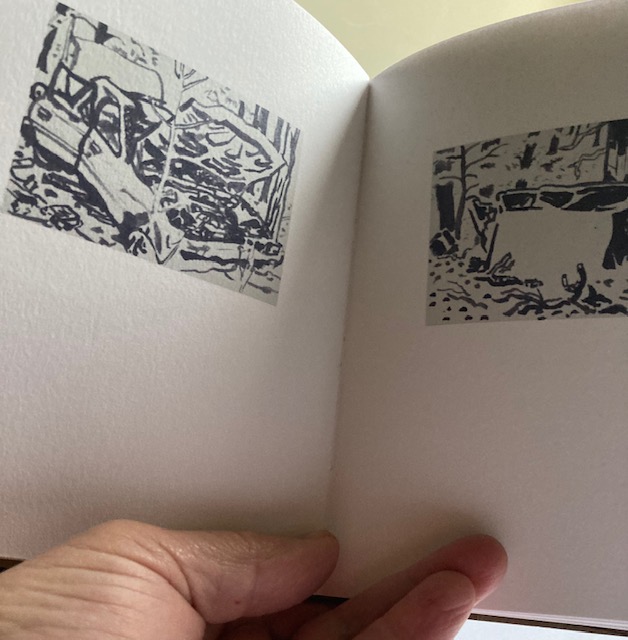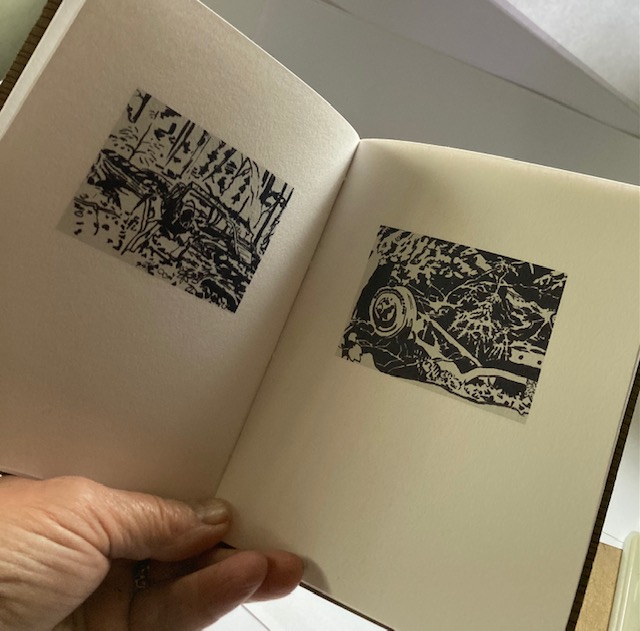£12.00
Jason Clark
Driven-Out Ditched and Deserted
Paper folded cover, 36 pages, 16 drawings
Published 2008 by Coracle Press, Ballybeg, Grange, Clonmel, Tipperary, Ireland
Edition of 300,
1 in stock
Description
Jason Clark: Driven-Out, Ditched and Deserted is a book of drawings of cars.Not just any cars, but cars abandoned in the wilderness. Drawn on location in ink in the woods of Northern New England it is a record of what the artist found while hiking. But more than that, as he says, it is a record of drawing decisions.
The cars, abandoned along old logging roads, ditched down ravines, driven in up to their wheel-wells in sand-pits, burned and bullet-ridden, and left to disintegrate and then integrate into nature. These are a dear armature for my work which tracts the edge where mark-making and legible image merge.
Jason Clark
Jason describes his drawing practice as the interacton between drawing and its subject. In a monotone drawing everything is pushed to one extremity or another. He speaks of the subject as an active agent in the process ‘striving to remain legible’ and which ‘contrives dialect for the drawing.
To find out more, you need to buy the book.
About Coracle Press
Coracle Press is a small and completely individual publishing press which has been operating for over 35 years. Writer and artist Erica Van Horn and poet, artist and editor Simon Cutts, direct it now from a small farm between the hills of South Tipperary, Ireland. They have been there since 1996. However, they began in London in the nineteen seventies, as publisher, gallery, and a space for books. Their last London book shop project project was ‘workfortheeyetodo’ in the mid-nineteen nineties. They also had a Norfolk connection, between 1989-2012, printing many of their works from a printer, Crome and Akers, based in King’s Lynn.
From their remote spot in Ireland, they continue as printer-publisher, editor of spaces. They describe their practice as ’employing many of the devices and formats of hypothetical publishing inherent in the small press’. Their books have both critical and playful dimensions. But they are also steeped in poetry – they call it a residue of poetry – concerned with the mechanisms of the book as a manifestation of the poem itself. They are also mindful of their many collaborations with other artists and writers, which evade any clear category.
Being open to new ideas and approaches marks all their projects. Limiting their scope or over-categorising their content or defining their range does not interest them. The books themselves are not so concerned with craft tradition, limited-ness of edition, hand-made paper or elaboration of binding. While each one has its unique character and appearance, what they want to achieve is the plain and simple case-bound book, the sewn paperback. They are working constantly at extending the category of ephemera. Making quirky visions, askance views, eccentric perceptions widely available is what they are all about.









